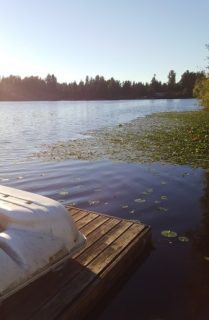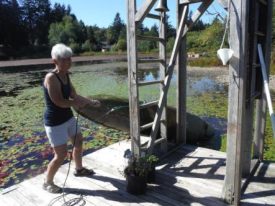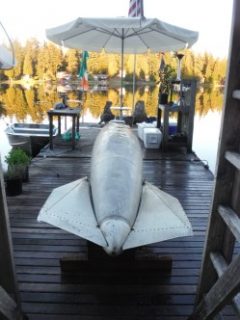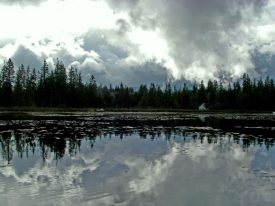From an article by Sasha Shaw of King County’s Noxious Weeds program, which originally appeared on the Noxious Weed blog: https://kingcountyweeds.com/2016/10/04/lake-residents-team-up-to-tackle-weed-problems/ in October 2016.
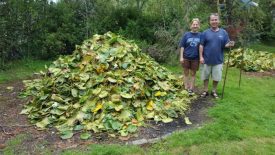
Volunteers Melanie Babyak and Randy Heppell standing by a huge pile of lily pads they helped remove. Photo by Steve Cameron.
The fact that weeds don’t respect property lines is even more obvious in and around lakes than anywhere else. Residents of four small King County lakes are showing that communities working together is the best way to overcome the challenges posed by lake weeds. By pooling their resources and volunteering their time, lakeside homeowners are saving money, improving the lakes’ habitats, and just getting more enjoyment out of living on a lake.
At Shadow Lake, a small lake in SE King County, residents formed a group called “Restore the Shore” in the summer of 2016 as part of an effort to control fragrant water lily and Eurasian watermilfoil. They organized via word of mouth and the Nextdoor networking site, and gathered technical information and advice with help from Ben Peterson, aquatic noxious weed specialist with King County. One homeowner bought a specialized cutting tool and other tools were borrowed from the King County Noxious Weed Program. Then eleven neighbors got busy removing fragrant water lily pads from areas of the lake shore.
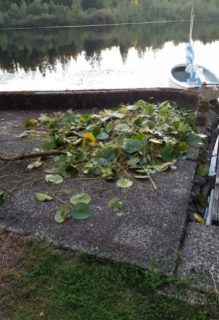
Water lily pads drying on a cement pad before being taken to the yard waste bin. Photo by Holly D’Annunzio.
According to organizer Holly D’Annunzio, the group quickly learned that removing lily pads is physical work and best done in teams of at least two people.
The benefits go beyond weed removal, though. Holly says, “The nice part of our efforts is that we now know our neighbors. At the end of summer I sponsored a potluck with live music and invited Restore the Shore and other neighbors who joined Nextdoor. People rowed boats to it. I hope to sponsor a neighborhood gathering quarterly. We learned a lot from Ben Peterson about how to care for our beautiful lake and now hope to develop as a neighborhood. Many thanks to Ben’s leadership – we appreciate his interest, skill, and guidance. We will continue to apply his methods on Shadow Lake for years to come.”
In another example, at Lake Kathleen east of Renton, Keith Lanan is leading a community effort to control aquatic weeds as well as some nuisance native plants. King County noxious weed program staff help out with the purple loosestrife control by releasing loosestrife-eating insects and doing spot treatment each year on any loosestrife they can reach from a canoe. However, the County hasn’t been able to help with the weeds growing in the water such as native nuisance plants and fragrant water lily.
To start tackling all the lake weeds, lake residents used their own funds and began by hiring a private contractor. When that proved too expensive, they learned from Ben how to do the work themselves. According to Keith, licensing, permitting and incorporating as a non-profit were very time-consuming, but worth the effort. By doing their own work, residents have saved a lot of money and have more flexibility to accommodate homeowner concerns, desires and schedules. They have also managed to greatly reduce the number of water lily, pondweed and other nuisance plants, have improved recreational access and achieved a more balanced habitat.
Keith got an unexpected bonus during his lily pad patrol this fall, when he found a submerged relic from 1950’s aviation. Keith and friends managed to haul out the hefty drop tank from a 1950’s jet fighter (a F-86 Saberjet according to Keith’s research). A journalist from the Renton Reporter even came out and wrote a story about it. You never know what you’ll find when controlling weeds in a lake!
At Lake Alice near Fall City, two determined volunteers are also leading a community effort to battle invasive water lily. Bill Wheeler and Gerry Brewster started by self-funding the work, but in 2011 they successfully applied for a King County Opportunity Grant to help cover the costs. They hired a commercial contractor at first, but costs went up and they realized they could save money doing it themselves. They transferred the state Ecology permit for removal to their community group, used some of the funds to buy a sprayer, and Bill got an aquatic pesticide license so he could do the spraying himself. Bill estimates it cost them less than $100 per year to control water lilies at the lake apart from the permit.
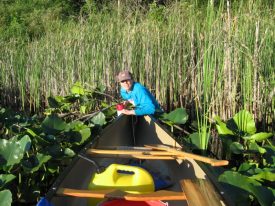
Spring Lake homeowner Tom Rohrer wading into the native pond lilies to control a purple loosestrife plant hiding in the cattails. Photo courtesy of Tom Rohrer.
Another lake with an active community-based weed control effort is Spring Lake, where a few diligent volunteers have been controlling the lake’s purple loosestrife infestations and keeping tabs on water lily and Eurasian milfoil for many years. Because of their ongoing commitment, each year less work is needed to keep the weeds in check.
These examples are just a few of the lakes in King County where the residents are teaming up to tackle weeds. Anyone interested in improving the habitat and recreational condition of a lake in King County can contact Ben Peterson, the Aquatic Weed Control Specialist at the King County Noxious Weed Control Program. For more information about aquatic weeds, download the program’s Water Weeds guide or visit the noxious weed program website. Any lakeside resident in King County can also learn how to detect lake weeds before they get established by becoming a Lake Weed Watcher.

